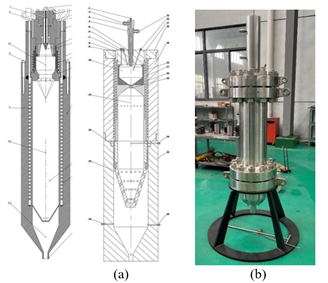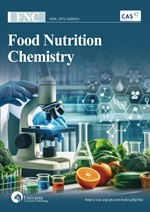Supercritical hydrothermal combustion: Basic principles, characteristics, applications, and development in energy and environment
DOI:
https://doi.org/10.18686/cest.v1i2.122Keywords:
supercritical hydrothermal combustion; combustion characteristics; numerical simulation; waste treatment; in-situ coal gasification; heavy oil thermal recoveryAbstract
Supercritical hydrothermal combustion technology is a new homogeneous combustion technology with high potential in the fields of efficient removal of organic waste, clean utilization of conventional fossil energy, and efficient recovery of heavy oil. In this paper, the literature related to supercritical hydrothermal combustion in recent years is reviewed, focusing on evaluating the current status of experimental and numerical simulation studies on the characteristics of supercritical hydrothermal combustion, as well as the latest progress in engineering. It has been pointed out that the reduction of ignition temperature and extinction temperature is the key to promoting the application of supercritical hydrothermal combustion technology, and the consideration of the real fluid’s effects and turbulence reaction interactions can correctly reflect the combustion process. In addition, supercritical hydrothermal combustion technology, as a source of heat and reaction medium supply, can realize the efficient removal of highly concentrated organic wastewater, the clean combustion of coal, and in-situ hydrogen production, as well as the thermal recovery of heavy oil by multi-thermal fluids. At present, supercritical hydrothermal combustion forced ignition technology, reactor design guidelines, and corrosion prevention of key equipment are still the focus of future research, which is of great significance to promote the application of supercritical hydrothermal combustion technology.

Downloads
Published
How to Cite
Issue
Section
License
Copyright (c) 2023 Zicheng Li, Yanhui Li, Shuzhong Wang, Mengmeng Ren, Yuanwang Duan, Hui Liu

This work is licensed under a Creative Commons Attribution-NonCommercial 4.0 International License.
References
1. National Bureau of Statistics. Statistical bulletin of the national economic and social development of the People’s Republic of China in 2022 (Chinese). China Statistics 2023; 3: 12–29.
2. Liu S, Chang Z, Liu J. Key technologies and prospect for in-situ gasification mining of deep coal resources. Journal of Mining Science and Technology 2021; 6(3): 261–270. doi: 10.19606/j.cnki.jmst.2021.03.002
3. Huang S, Cao M, Cheng L. Experimental study on the mechanism of enhanced oil recovery by multi-thermal fluid in offshore heavy oil. International Journal of Heat and Mass Transfer 2018; 122: 1074–1084. doi: 10.1016/j.ijheatmasstransfer.2018.02.049
4. Schilling W, Franck EU. Combustion and diffusion flames at high pressures to 2000 bar. Berichte der Bunsengesellschaft für physikalische Chemie 1988; 92(5): 631–636. doi: 10.1002/bbpc.198800149
5. Steeper RR, Rice SF, Brown MS, et al. Methane and methanol diffusion flames in supercritical water. The Journal of Supercritical Fluids 1992; 5(4): 262–268. doi: 10.1016/0896-8446(92)90017-e
6. Sobhy A, Guthrie RIL, Butler IS, et al. Naphthalene combustion in supercritical water flames. Proceedings of the Combustion Institute 2009; 32(2): 3231–3238. doi: 10.1016/j.proci.2008.06.173
7. Meier T, Schuler MJ, Stathopoulos P, et al. Hot surface ignition and monitoring of an internal oxygen–ethanol hydrothermal flame at 260 bar. The Journal of Supercritical Fluids 2017; 130: 230–238. doi: 10.1016/j.supflu.2016.09.015
8. Wellig B, Weber M, Lieball K, et al. Hydrothermal methanol diffusion flame as internal heat source in a SCWO reactor. The Journal of Supercritical Fluids 2009; 49(1): 59–70. doi: 10.1016/j.supflu.2008.11.021
9. Stathopoulos P, Ninck K, von Rohr PR. Hot-wire ignition of ethanol–oxygen hydrothermal flames. Combustion and Flame 2013; 160(11): 2386–2395. doi: 10.1016/j.combustflame.2013.05.006
10. Bermejo MD, Cabeza P, Queiroz JPS, et al. Analysis of the scale up of a transpiring wall reactor with a hydrothermal flame as a heat source for the supercritical water oxidation. The Journal of Supercritical Fluids 2011; 56(1): 21–32. doi: 10.1016/j.supflu.2010.11.014
11. Bermejo MD, Jiménez C, Cabeza P, et al. Experimental study of hydrothermal flames formation using a tubular injector in a refrigerated reaction chamber. Influence of the operational and geometrical parameters. The Journal of Supercritical Fluids 2011; 59: 140–148. doi: 10.1016/j.supflu.2011.08.009
12. Cabeza P, Silva Queiroz JP, Criado M, et al. Supercritical water oxidation for energy production by hydrothermal flame as internal heat source. Experimental results and energetic study. Energy 2015; 90: 1584–1594. doi: 10.1016/j.energy.2015.06.118
13. Hicks MC, Hegde UG, Kojima JJ. Hydrothermal ethanol flames in Co-flow jets. The Journal of Supercritical Fluids 2019; 145: 192–200. doi: 10.1016/j.supflu.2018.12.010
14. Xu D, Wang S, Huang C, et al. Transpiring wall reactor in supercritical water oxidation. Chemical Engineering Research and Design 2014; 92(11): 2626–2639. doi: 10.1016/j.cherd.2014.02.028
15. Cui C, Li Y, Wang S, et al. Review on an advanced combustion technology: Supercritical hydrothermal combustion. Applied Sciences 2020; 10(5): 1645. doi: 10.3390/app10051645
16. Shaw RW. Supercritical water a medium for chemistry. Chemical Engineering News 1991; 69(51): 26–39. doi: 10.1021/cen-v069n051.p026
17. Huang G. Properties of water in supercritical state (Chinese). Northwest China Electric Power 2004; 4: 82–84, 86.
18. Liu X, Guo Y, Lin L. Application of super (sub)critical water in chemical reactions (Chinese). Inner Mongolia Petrochemical Industry 2008; 3: 34–37.
19. Tian Y, Feng J, Qin Y, et al. Properties of supercritical water and its application in chemical reactions (Chinese). Chemistry (Huaxue Tongbao) 2002; 6: 396–402.
20. YangK, Xu M, Lin C. Physical and chemical properties of supercritical water (Chinese). Journal of Zhejiang University of Technology 2001; 4: 66–70.
21. Zhang L, Chen L, Zhao X, et al. Properties of supercritical water and its application. Chemical Industry and Engineering 2003; 20(1): 33–38, 54.
22. Augustine C, Tester JW. Hydrothermal flames: From phenomenological experimental demonstrations to quantitative understanding. The Journal of Supercritical Fluids 2009; 47(3): 415–430. doi: 10.1016/j.supflu.2008.10.003
23. Reddy SN, Nanda S, Hegde UG, et al. Ignition of hydrothermal flames. RSC Advances 2015; 5(46): 36404–36422. doi: 10.1039/c5ra02705e
24. Jiang Z, Li Y, Wang S, et al. Review on mechanisms and kinetics for supercritical water oxidation processes. Applied Sciences 2020; 10(14): 4937. doi: 10.3390/app10144937
25. Henrikson JT, Grice CR, Savage PE. Effect of water density on methanol oxidation kinetics in supercritical water. The Journal of Physical Chemistry A 2006; 110(10): 3627–3632. doi: 10.1021/jp057184u
26. Holgate HR, Tester JW. Fundamental kinetics and mechanisms of hydrogen oxidation in supercritical water. Combustion Science and Technology 1993; 88(5–6): 369–397. doi: 10.1080/00102209308947245
27. Fujii T, Hayashi R, Kawasaki S, et al. Water density effects on methanol oxidation in supercritical water at high pressure up to 100 MPa. The Journal of Supercritical Fluids 2011; 58(1): 142–149. doi: 10.1016/j.supflu.2011.04.004
28. Boock LT, Klein MT. Lumping strategy for modeling the oxidation of C1–C3 alcohols and acetic acid in high-temperature water. Industrial & Engineering Chemistry Research 1993; 32(11): 2464–2473. doi: 10.1021/ie00023a004
29. Cabeza P, Bermejo MD, Jiménez C, et al. Experimental study of the supercritical water oxidation of recalcitrant compounds under hydrothermal flames using tubular reactors. Water Research 2011; 45(8): 2485–2495. doi: 10.1016/j.watres.2011.01.029
30. Zhang J, Wang S, Xu D, et al. Kinetics study on hydrothermal combustion of methanol in supercritical water. Chemical Engineering Research and Design 2015; 98: 220–230. doi: 10.1016/j.cherd.2015.05.002
31. Zhang F, Zhang Y, Xu C, et al. Experimental study on the ignition and extinction characteristics of the hydrothermal flame. Chemical Engineering & Technology 2015; 38(11): 2054–2066. doi: 10.1002/ceat.201300571
32. Bermejo MD, Cabeza P, Bahr M, et al. Experimental study of hydrothermal flames initiation using different static mixer configurations. The Journal of Supercritical Fluids 2009; 50(3): 240–249. doi: 10.1016/j.supflu.2009.06.010
33. Sobhy A, Butler IS, Kozinski JA. Selected profiles of high-pressure methanol–air flames in supercritical water. Proceedings of the Combustion Institute 2007; 31(2): 3369–3376. doi: 10.1016/j.proci.2006.07.253
34. Reddy SN, Nanda S, Kumar P, et al. Impacts of oxidant characteristics on the ignition of n-propanol-air hydrothermal flames in supercritical water. Combustion and Flame 2019; 203: 46–55. doi: 10.1016/j.combustflame.2019.02.004
35. Hirth Th, Franck EU. Oxidation and hydrothermolysis of hydrocarbons in supercritical water at high pressures. Berichte der Bunsengesellschaft für physikalische Chemie 1993; 97(9): 1091–1097. doi: 10.1002/bbpc.19930970905
36. Savage PE. Organic chemical reactions in supercritical water. Chemical Reviews 1999; 99(2): 603–622. doi: 10.1021/cr9700989
37. Meier T, Stathopoulos P, von Rohr PR. Hot surface ignition of oxygen–ethanol hydrothermal flames. The Journal of Supercritical Fluids 2016; 107: 462–468. doi: 10.1016/j.supflu.2014.11.012
38. Wellig B, Lieball K, von Rohr Rudolf. Operating characteristics of a transpiring-wall SCWO reactor with a hydrothermal flame as internal heat source. Journal of Supercritical Fluids 2005; 34(1): 35–50. doi: 10.1016/j.supflu.2004.07.003
39. Zhang F, Chen S, Xu C, et al. Experimental study on the effects of operating parameters on the performance of a transpiring-wall supercritical water oxidation reactor. Desalination 2012; 294: 60–66. doi: 10.1016/j.desal.2012.03.013
40. Zhang F, Xu C, Zhang Y, et al. Experimental study on the operating characteristics of an inner preheating transpiring wall reactor for supercritical water oxidation: Temperature profiles and product properties. Energy 2014; 66: 577–587. doi: 10.1016/j.energy.2014.02.003
41. Bermejo MD, Fdez-Polanco F, Cocero MJ. Experimental study of the operational parameters of a transpiring wall reactor for supercritical water oxidation. The Journal of Supercritical Fluids 2006; 39(1): 70–79. doi: 10.1016/j.supflu.2006.02.006
42. Serikawa R. Hydrothermal flames in supercritical water oxidation: Investigation in a pilot scale continuous reactor. Fuel 2002; 81(9): 1147–1159. doi: 10.1016/s0016-2361(02)00015-7
43. Cabeza P, Queiroz JPS, Arca S, et al. Sludge destruction by means of a hydrothermal flame. Optimization of ammonia destruction conditions. Chemical Engineering Journal 2013; 232: 1–9. doi: 10.1016/j.cej.2013.07.040
44. Príkopský K. Characterization of Continuous Diffusion Flames in Supercritical Water [PhD thesis]. ETH Zurich; 2007.
45. Schanzenbächer J, Taylor JD, Tester JW. Ethanol oxidation and hydrolysis rates in supercritical water. The Journal of Supercritical Fluids 2002; 22(2): 139–147. doi: 10.1016/s0896-8446(01)00119-x
46. Vogel F, Blanchard JLD, Marrone PA, et al. Critical review of kinetic data for the oxidation of methanol in supercritical water. The Journal of Supercritical Fluids 2005; 34(3): 249–286. doi: 10.1016/j.supflu.2003.12.018
47. Ren M. Research on Supercritical Hydrothermal Combustion Mechanism Using Reaction Kinetics Coupled Flow Model [PhD thesis]. Xi’an Jiaotong University; 2019.
48. Brock EE, Savage PE. Detailed chemical kinetics model for supercritical water oxidation of C1 compounds and H2. AIChE Journal 1995; 41(8): 1874–1888. doi: 10.1002/aic.690410806
49. Baulch DL, Cobos CJ, Cox RA, et al. Evaluated kinetic data for combustion modelling. Journal of Physical and Chemical Reference Data 1992; 21(3): 411. doi: 10.1063/1.555908
50. Baulch DL, Cobos CJ, Cox RA, et al. Evaluated kinetic data for combustion modeling. Supplement I. Journal of Physical and Chemical Reference Data 1994; 23(6): 847–848. doi: 10.1063/1.555953
51. Marinov NM. A detailed chemical kinetic model for high temperature ethanol oxidation. International Journal of Chemical Kinetics 1999; 31(3): 183–220. doi: 10.1002/(SICI)1097-4601(1999)31:3<183::AID-KIN3>3.0.CO;2-X
52. Rice SF, Croiset E. Oxidation of simple alcohols in supercritical water III. Formation of intermediates from ethanol. Industrial & Engineering Chemistry Research 2000; 40(1): 86–93. doi: 10.1021/ie000372g
53. Ploeger JM, Green WH, Tester JW. Co-oxidation of methylphosphonic acid and ethanol in supercritical water. The Journal of Supercritical Fluids 2006; 39(2): 239–245. doi: 10.1016/j.supflu.2006.03.003
54. Ren M, Wang S, Zhang J, et al. Characteristics of methanol hydrothermal combustion: Detailed chemical kinetics coupled with simple flow modeling study. Industrial & Engineering Chemistry Research 2017; 56(18): 5469–5478. doi: 10.1021/acs.iecr.7b00886
55. Li L, Chen P, Gloyna EF. Generalized kinetic model for wet oxidation of organic compounds. AIChE Journal 1991; 37(11): 1687–1697. doi: 10.1002/aic.690371112
56. Hayashi R, Onishi M, Sugiyama M, et al. Kinetic analysis on alcohol concentration and mixture effect in supercritical water oxidation of methanol and ethanol by elementary reaction model. The Journal of Supercritical Fluids 2007; 40(1): 74–83. doi: 10.1016/j.supflu.2006.04.006
57. Ploeger JM, Green WH, Tester JW. Co‐oxidation of ammonia and ethanol in supercritical water, part 2: Modeling demonstrates the importance of H2NNOx. International Journal of Chemical Kinetics 2008; 40(10): 653–662. doi: 10.1002/kin.20345
58. Benjamin KM, Savage PE. Detailed chemical kinetic modeling of methylamine in supercritical water. Industrial & Engineering Chemistry Research 2005; 44(26): 9785–9793. doi: 10.1021/ie050926l
59. Dinaro JL, Howard JB, Green WH, et al. Analysis of an elementary reaction mechanism for benzene oxidation in supercritical water. Proceedings of the Combustion Institute 2000; 28(2): 1529–1536. doi: 10.1016/s0082-0784(00)80550-0
60. Gao Z, Wang H, Song C, et al. Real-fluid effects on laminar diffusion and premixed hydrothermal flames. The Journal of Supercritical Fluids 2019; 153: 104566. doi: 10.1016/j.supflu.2019.104566
61. Chung TH, Ajlan M, Lee LL, et al. Generalized multiparameter correlation for nonpolar and polar fluid transport properties. Industrial & Engineering Chemistry Research 1988; 27(4): 671–679. doi: 10.1021/ie00076a024
62. Narayanan C, Frouzakis C, Boulouchos K, et al. Numerical modelling of a supercritical water oxidation reactor containing a hydrothermal flame. The Journal of Supercritical Fluids 2008; 46(2): 149–155. doi: 10.1016/j.supflu.2008.04.005
63. Sierra-Pallares J, Teresa Parra-Santos M, García-Serna J, et al. Numerical modelling of hydrothermal flames. Micromixing effects over turbulent reaction rates. The Journal of Supercritical Fluids 2009; 50(2): 146–154. doi: 10.1016/j.supflu.2009.05.001
64. Poling BE, Prausnitz JM, O’Connell JP. The Properties of Gases and Liquids, 5th ed. McGraw-Hill; 2001.
65. Hjertager LK, Hjertager BH, Solberg T. CFD modelling of fast chemical reactions in turbulent liquid flows. Computers & Chemical Engineering 2002; 26(4–5): 507–515. doi: 10.1016/s0098-1354(01)00799-2
66. Mathur GP, Thodos G. The self‐diffusivity of substances in the gaseous and liquid states. AIChE Journal 1965; 11(4): 613–616. doi: 10.1002/aic.690110411
67. Zhang J, Ren M, Li Y, et al. Continuous supercritical hydrothermal combustion experimental and burner structure optimization simulation study. Chemical Engineering Research and Design 2022; 188: 69–80. doi: 10.1016/j.cherd.2022.09.039
68. Song C. Direct Numerical Simulation Study of Supercritical Hydrothermal Combustion (Chinese) [PhD thesis]. Zhejiang University; 2020.
69. Qian L, Wang S, Ren M, et al. Co-oxidation effects and mechanisms between sludge and alcohols (methanol, ethanol and isopropanol) in supercritical water. Chemical Engineering Journal 2019; 366: 223–234. doi: 10.1016/j.cej.2019.02.046
70. Ren M, Wang S, Yang C, et al. Supercritical water oxidation of quinoline with moderate preheat temperature and initial concentration. Fuel 2019; 236: 1408–1414. doi: 10.1016/j.fuel.2018.09.091
71. Zhang J, Li P, Lu J, et al. Supercritical water oxidation of ammonia with methanol as the auxiliary fuel: Comparing with isopropanol. Chemical Engineering Research and Design 2019; 147: 160–170. doi: 10.1016/j.cherd.2019.05.010
72. Zhang J, Li P, Lu J, et al. Supercritical hydrothermal combustion of nitrogen-containing compounds in a tubular reactor. Fuel 2020; 275: 117889. doi: 10.1016/j.fuel.2020.117889
73. Fujie M, Inui A, Anjo KJ, et al. Study of combustion behavior of brown coal in supercritical water. High Pressure Research 2001; 20(1–6): 385–392. doi: 10.1080/08957950108206186
74. Ma H. Research on Basic Issues of Coal Supercritical Water Gasification Coupled Hydrothermal Combustion Power Generation System (Chinese) [PhD thesis]. Xi’an Jiaotong University; 2013.
75. Bermejo MD, Cocero MJ, Fernández-Polanco F. A process for generating power from the oxidation of coal in supercritical water. Fuel 2004; 83(2): 195–204. doi: 10.1016/s0016-2361(03)00256-4
76. Liang W. Research on the Hydrothermal Combustion of Coal in Supercritical Water [Master’s thesis]. Xi’an Jiaotong University; 2007.
77. Chen J, Wang L, Cheng Z, et al. Performance simulation and thermodynamics analysis of hydrogen production based on supercritical water gasification of coal. International Journal of Hydrogen Energy 2021; 46(56): 28474–28485. doi: 10.1016/j.ijhydene.2021.06.097
78. Zhang F, Wang S, Duan Y, et al. Thermodynamic assessment of hydrothermal combustion assisted fossil fuel in-situ gasification in the context of sustainable development. Fuel 2023; 335: 127053. doi: 10.1016/j.fuel.2022.127053
79. Liu W, Wan Y, Xiong Y, et al. Green hydrogen standard in China: Standard and evaluation of low-carbon hydrogen, clean hydrogen, and renewable hydrogen. International Journal of Hydrogen Energy 2022; 47(58): 24584–24591. doi: 10.1016/j.ijhydene.2021.10.193
80. Guo Y. Research progress of viscosity reduction of heavy oil. Contemporary Chemical Industry 2019; 48(1): 4.
81. He W, Li Z, Li Y, et al. Prospects of supercritical hydrothermal combustion as recovery technology for heavy oil reservoirs. Geoenergy Science and Engineering 2023; 227: 211795. doi: 10.1016/j.geoen.2023.211795
82. Wang S, Xu H, Li Y, et al. A Supercritical Hydrothermal Combustion Steam Generator for Ultra-Deep Underground Heavy Oil Thermal Recovery (Chinese). China Patent 110617466A, 27 December 2019.
83. Wang S, Cui C, Li Y, et al. A Supercritical Hydrothermal Combustion Device Suitable for High-Viscosity Fuels (Chinese). China Patent CN110645555A, 3 January 2020.
84. Geng Y, Wang S, Zhang F, et al. Numerical investigations on hydrothermal flame characteristics of water-cooled hydrothermal burner. International Journal of Chemical Reactor Engineering 2023; 21(10): 1225–1239. doi: 10.1515/ijcre-2023-0040




.jpg)
.jpg)

